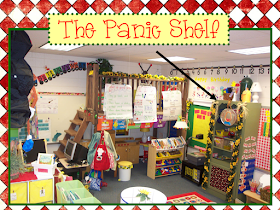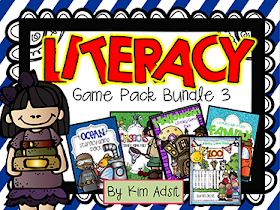As part of the webinar, teachers were invited to submit questions. There is no way to answer all of them in this blog post, so I have picked a few.
Here are some of the questions:
What do you do about kids who have trouble learning the alphabet?
I love Reading Recovery. When I was a young teacher we had a Reading Recovery teacher at our school. About once a month, she would come to our grade level meeting and share some strategies that she used as part of the program. Now, let me say...Reading Recovery is a one on one program. So we have to do some tweaking to the strategies if we are going to make them work in the classroom setting. Here is how I adjusted the ABC Book:1. Test all of the children in your room. At the beginning of a kindergarten year, children who know around 18 capital and 16 lower case, will be fine! You don't need an intervention. They will get the letters just by singing and playing games. Those children who know ZERO are not ready! They need time to come to school and be surrounded by literacy. These are kids that probably have limited exposure to text in their homes. It is the children in the middle that will benefit the most!
2. Using the cover above and the abc pages, make each child a book. You will want to first do this with just a few children. Trying to do this with a large number of children can become overwhelming.(There is a link for this free resource at the end of this question.)
3. Cut the pictures apart and...
put them in a baggie.
4. Using the assessment, invite the children to glue in the picture for each letter that they knew. They can know JUST the capital or JUST the lower case! Still give them the picture. The letters that they do not know will not have a picture glued in. Now, give them 3 new letters that they do not know. Invite them to glue the pictures on those three letters. Mark these 3 pages with a sticky note.
4. Now it is time to read the book. If there is no picture, just skip the page. When they get to a page with a picture they point to the capital letter and say the letter, point to the lower case letter and say the letter, point to the picture and name it. If they are able to name one of the letters on the page with a sticky note, remove the sticky note. Put the sticky note on another page without a picture.
You can get the directions and the abc book pages at the bottom of this blog post.
I want to know how you would suggest integrating readers theater in the lower grades.
1. Readers Theater is a fun way to practice working as a team. It is a great way to develop prosody.When I write my reader's theater scripts, I make the different characters each have a different level of text. This allows me to make teams that work well together! It also puts some of your leaders in each group. And most importantly, all kids feel proud and successful!
2. We print the scripts black and white using the booklet option in the print menu. Print a booklet for each character. Use a highlighter to highlight his parts.
3. Depending on your printer, it might print back and front without you doing anything! Some printers will tell you to flip your papers to print the other side.
4. For the kids who aren't quite ready for a script, I use these character cards. The kids hold the cards as they role play the story. It is like an oral "readers theater"!
You can find my Reader's Theater Bundle here.
How do you organize all of your props that you use throughout the year?
Organization is something we are all always working on. One organization tip for the classroom is my Panic Shelf. This shelf holds everything I need during the day. It will have the things I use all year such as my calendar supplies, but it also hold puppets and items that I will use that day. I also keep a sets of puppets, like the Five Little Ducks, on the shelf to use during transitions.I tend to store my things at home in our garage--sorry kids park in the driveway! Each of the stacks represents about a month of teaching. Once a month I load things in my car and take it to the school to swap things out. The brain is constantly seeking novelty. We need a way to rotate materials so that things are always new! These tubs store center props, class décor, teaching resources, puppets, etc.
My husband made me these bags to hold the large anchor charts/posters, etc. It holds the things that are too large for the tubs. I hate rolling or folding the charts! You can also use the XXXL Ziploc Bags. I pick them up at Target.
I follow your blog and love your resources. I have rearranged my room to have different zones. I was wondering what your schedule looks like.
You can download a different version of my daily schedule in this blog post.

I love your Simply Science units. Will there be more?
Yes! I started off thinking I could keep up with these! These require tons of research and thought. It's not something I can do when I'm tired or when the grandkids are around. I have to use all of my brain power. I'm hoping to have some more ready to go for next year! I have already written three units--The Scientific Method and Science Tools, The Sun and Other Stars, and The Moon.
What are your favorite free resources?
- There are sooooo many free resources available. There are free things all over social media--on blogs, pinterest, facebook, tpt.
Will you post the link to the resources in today's webinar?
Here are the resources I used to plan the webinar. You can click on the image to find the resource.https://www.teacherspayteachers.com/Product/Jack-Hartmann-I-Know-An-Old-Lady-Fun-Music-Book-98687
These are the books that I used in the presentation. You can click on the title and it will take you to amazon.

























No comments:
Post a Comment
Note: Only a member of this blog may post a comment.